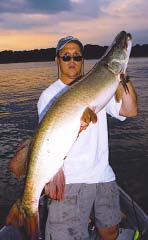|
|

Posts: 341
| What's your opinion on lake chains and muskie migration? Drill down a bit, if you have a three lake system with dramatic depth differences, water clarity, forage, and structure do they really travel back and forth by seasonal patterns? I've been noticing different muskie sweaters and size lately that belong in another lake in the chain.
Heading out today for some 25mph wind and cold, good thing I've been eating like Elvis and have my 10lb fat layer intact for Suuueeeyyy hunting.
| |
| | |

Posts: 32935
Location: Rhinelander, Wisconsin | Muskies do move around some, that's for sure. Not sure about migration though, that would infer something that happens every year. Is there a prey based possibility there? | |
| | |
Posts: 149
| That exact question of seasonal musky migration has been answered in a recent study completed on the Manitowish Chain in northern Wisconsin.
The study was done as a graduate thesis in 2004 - 2005 by Jordan Weeks, who was obviously at the time a graduate student at UW - Stevens Point. Jordan now works for the WDNR and is on the Musky Management Team.
The thesis is titled "Walleye and Muskellunge Movement in the Manitowish Chain of Lakes, Vilas County, Wisconsin" and makes for some very interesting reading. Here is a link to the entire text of the thesis:
http://www.manitowishwaters.org/walleyestudy.pdf
There are also several other studies that might shed more light on your question in the references section at the end of the thesis.
Edited by esoxcpr 10/10/2007 9:45 PM
| |
| | |

Posts: 341
| The deep Cisco lake hasn't turned and with the water temperature dropping, the esox in the deep Cisco lake migrate to another lake with a perch, crappie forage until they can gorge on Cisco that move up East reef. A daily fisherman on this chain believes the above statement, but local guides shoot down the idea.
esoxcpr I'll give it a read, thanks.
| |
| | |

Posts: 32935
Location: Rhinelander, Wisconsin | Very interesting read. Movement between lakes was reported to be pretty common, but the study length wouldn't allow detection of a 'migratory' pattern, I don't believe. Maybe we can get Mr. Weeks to comment. | |
| | |
| Steve, you lucked out...I haven't looked at these boards all summer and happened to be browsing today...
You are correct in saying that migratory patterns couldn't be statistically determined by my study. WE would need a different study design for that.
However, anecdotally I did notice some pretty interesting things while following 36 fish for 19 months.
First, most fish that moved from one lake to another (41%) did so in spring and fall
Second, fish home range was about the size of four football fields (info not in the thesis)-meaning that 59% of the fish remained in the same general area throughout the year. In general, the area (home range-approx 4 acres) in which a fish lives usually has both deep and shallow water plus heavy cover in some form (veg, rocks, wood, boat dock)-so from my experience those fish simply move from cover type to cover type based on food availability and season, but typically still remain within that home range.
Third, fish in a shallow weedy lake (ie. Wild Rice) don't take off for the nearset place/lake with 50 foot of water. Sure some fish move out but there may also be some fish that move in. So, usually there is no "net loss" of muskies. Often fish in shallow weed lakes are still associated with the deepest water they acn find-relitive to the rest of the lake.
I may write more when I have time.
I hope this helps a bit. Good luck fishing-I hope you all catch a fatty!
Jordan | |
| | |

Posts: 1996
Location: Pelican Lake/Three Lakes Chain | Jordan,
Thank you for that post. Your study and the information generated from it has some of the most useful info I have seen in years on musky location and home ranges. Antime you want to share more please do. | |
| |
|
 Seasonal Chain Lake Migration
Seasonal Chain Lake Migration Seasonal Chain Lake Migration
Seasonal Chain Lake Migration